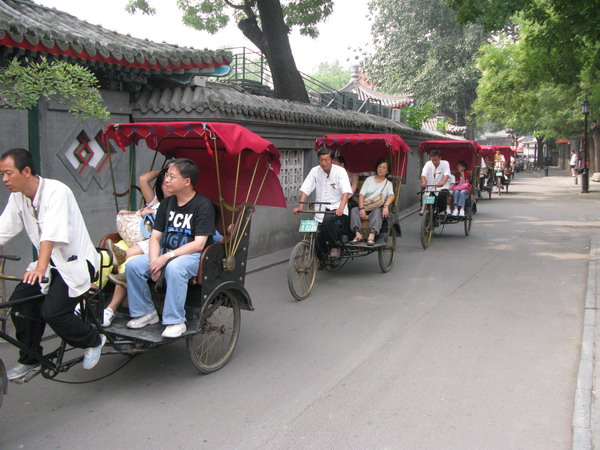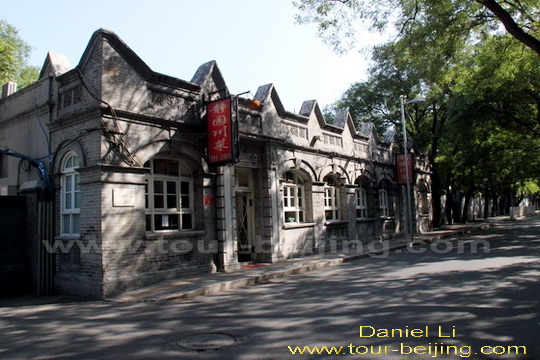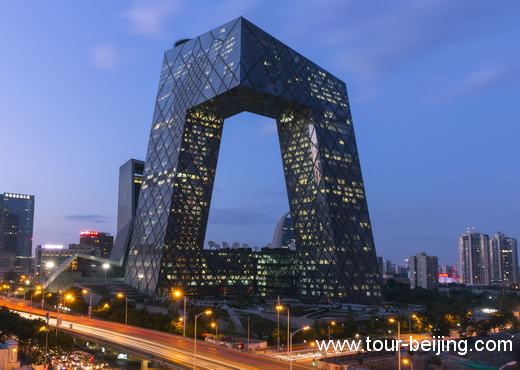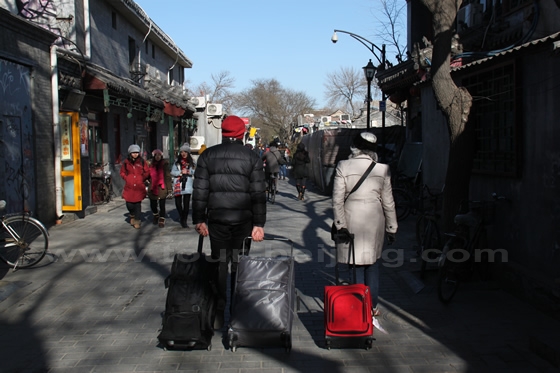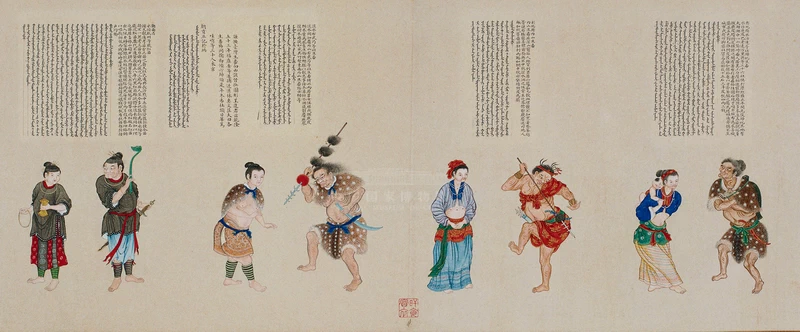Plan your Beijing hutong tour? Basically a glimpse of the old hutongs in Beijing will be crammed into a travel plan for most of the first-time visitors coming to Beijing. Why hutongs? In a sense, the modern Beijing was born from hutongs, the unique and vernacular buildings or architectures in Beijing.
The hutongs in Beijing originated in the Yuan Dynasty (1279–1368) . Today, there are still many old hutong left, kept intact or revamped. A short trip to hutongs helps you have a whole picture of Beijing, both spiritually or physically.
We round up the top 10 hutongs in Beijing, which are often lauded as the most famous representing the authentic old Beijing. Follow us for the virtual tour of these amazing old hutongs, each of which has a story and deep past with strong Beijing flavor.
Nanluoguxiang Hutong 南锣鼓巷
The 786-meter long south-north Nanluoguxiang Hutong is lined with numerous trendy bars, yummy restaurants, unique hostels, lively themed stores and itinerant vendors.

There are also 8 hutongs hidden on the east and west sides of the main and wider lane of Nanluoguxiang as well as former residences and mansions where loyal families and celebrities who once lived.
Nanluoguxiang is easily accessible by Subway Line 6 and get off at the station of Nanluoguxiang. Then enter the south entrance to Nanluoguxiang and exit from its north.
You can also walk further northward from Forbidden City’s northern gate to Nanluoguxiang over half a hour.
Dong Jiao Min Xiang 东交民巷
Dong Jiao Minj Xiang ( or Dong Jiao Min Alley ) literally means “East Foreign Residents Alley”, which is the longest alley ( hutong ) in Beijing with a total length of 1550 meters.
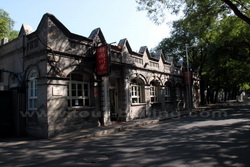
In the English travel guidebooks, Dong Jiao Min Xiang is popularly known as Former Legation Quarter. It was once home to the former 11 foreign embassies including UK, France, Germany, Japan, the US, Russia, Italy, Spain, Austria, Belgium and Dutch.
The historic alley is open all year round without any entrance fee. Dong Jiao Min Xiang is an east-west hutong with its west end ( west entrance ) connected to the east of Tiananmen Square and its east end ( east entrance ) close to the Exit A of the subway station of Chongwenmen ( subway line 2).
A walk along Dong Jiao Min Alley is often done either before or after your visit to Tiananmen Square. So if you prefer to visit Dong Jiao Min Xiang before your tour of Tiananmen Square, you may take subway line 2 and get off at the station of Chongwenmen and exit from Exit A.
Yandai Xiejie 烟袋斜街
Yandai Xiejie ( or Yandai Byway 烟袋斜街) is one of such old commercial streets that showcase Beijing’s past. Yandai Byway was originally formed in Yuan Dynasty (1271 – 1368) and further developed and reached its height in late Qing Dynasty (1644-1911). Yandai, literally “Smoking Pipes”, was once lined up with many shops selling smoking pipes, hence the name of Yandai.
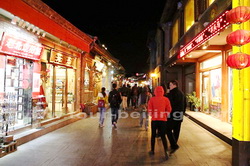
Yandai Byway is 232 meter long and 5-6 meter wide. It is located about 50 meters south of Drum Tower, lying from east to west, actually running a bit to the southwest, giving it the name of “Byway” which pronounces “Xiejie” in Chinese. So Yandai Byway is often called as “Yandaixiejie” or “Yandai Xiejie”.
Yandai Byway’s west end is connected to Yaer Hutong and Yinding Bridge to the south. On Nov 10, 2010, Yandai Xiejie was credited by Ministry of Culture, P.R.China as “China Famous Historical Cultural Street”.
Liulichang Antique Street 琉璃厂
On both side of the street there are plenty of storefronts and vendor’s stalls selling collectibles and art supplies, including the renowned Rongbaozhai, the most prominent shop on the west section of Liulichang.
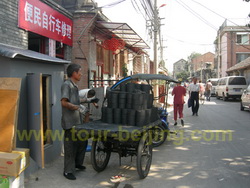
It sells woodblock prints, copies of famous calligraphy, historic paintings (reproductions), and art supplies.
It is one of Beijing’s top art shops and well worth browsing. Actually Rongbaozhai is located on the west section of Liulichang Street. To get to Liulichang Xijie ( the west section of Liulichang Street) on your right side, you have to across the main street.
Location: Liulichang Street, Xicheng District
地址:西城区琉璃厂
Opening Hours: 8:30am-7pm
Subway: take subway line 2 and get off at the station of Hepingmen (和平门), and exit from the Exit C2 (check old Beijing Walking Tour for more information.)
Bus No.s 6, 14, 15, 25, 50, 53, 57, 102 and 105.
Guozijian Street 国子监街
Guozijian Street is actually formerly known as Chengxian Street (成贤街). But it is more popular known as Guozijian Street since on the street is lined with Guozijian (The Imperial College) and Confucian Temple, which have been coalesced into one museum renamed “Confucian Temple and Guozijian Museum” since June, 2008.
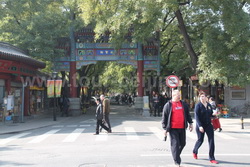
A stroll along shady Chengxian Street ( Guozijian Street), the east-west roadway, starting about 700 years ago with its structures built in line with ancient Chinese customs, once one of the China’s most important humanist centers.- the Confucius Temple and Guozijian (Imperial College).
Subway:
Subway Line 2: get off at Yonghegong (Lama Temple) Station, come out of the station from Exit C (Southwest Exit), and walk south about 500 meters, then you’ll find Chengxian Jie (Chengxian Street) on your right hand and walk westward for 200 meters, and you will find Confucian Temple and Guozijian Imperial College on your right side.
Subway Line 5: get off at Yonghegong (Lama Temple )Station, and come out of the station from Exit D (Southwest Exit).
Bus Route:
Take bus 3, 116 or 117 and get off at Yonghegong Station.
Take bus 13, 18, 44(小), 44(大), 62, 75, 116, 606, 800(内), 800 (外), 909 or 特2
Take bus 125 and get off at Yonghegong Qiao Bei Station.
Maoer Hutong ( Hat Alley ) 帽儿胡同
Maoer Hutong belongs to Jiaodaokou Street, Dongcheng District, Beijing, starting from From Nanluoguxiang in the east, west to Di ‘anmen Outer Street.
In the Qing Dynasty, it was renamed Hat Alley (Maoer Hutong ) because of the hat-making workshops scattered along the hutong.
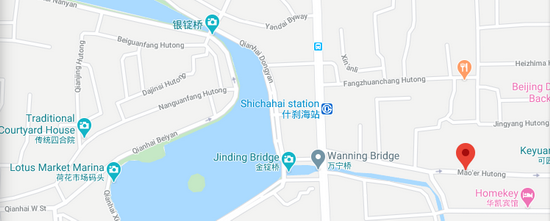
There are many well-preserved courtyards in Maoer Hutong: Maoer Hutong No. 5, Maoer Hutong No.9 (Keyuan Garden), Maoer Hutong No 11(Wen Yuzhai Mansion), Maoer Hutong No. 13 (Feng kuo-chang Former Residence), Maoer Hutong 21 (Wenchang Palace Ruins), Maoer Alley No. 37 (Empress Wanrong’s Former Residence), Maoer Hutong 45 (Qing Yamen, security forces of the republic of China), etc.
At the beginning of Maoer Hutong, it also intersects with the famous Nanluoguxiang Lane. There is the Yandai Xiejie Street at the end, so if you want to come here to visit, feeling the kind of atmosphere of the old Beijing city, Hat alley is a good choice.
Juer Hutong 菊儿胡同
Juer Hutong is located in the northwest of Dongcheng District of Beijing, starting from Jiaodaokou South Street in the east, reaching Nanluoguxiang in the west. It is under the jurisdiction of Jiaodaokou Sub-district office. It 438 meters long, 6 meters wide, an asphalt pavement. Now most of the north side of the alley has been demolished to build courtyard houses.
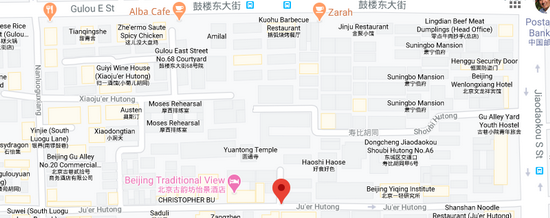
Waking out of Nanluoguxiang, you can reach Juer Hutong nearby. The most enduring parts of Beijing’s old city culture are presented here in the form of architecture, where each hutong has a glorious past and a chilling story to tell.
For example, No. 3, 5 and 7 Juer Hutong in Dongcheng were the residences of Ronglu during the reign of the Qing Emperor Guangxu. Number 3 is his former ancestral temple, number 5 is his former residence and number 7 is his former garden. Ronglu later moved to Dongchang Hutong.
Juer Hutong No.7 once served as the Afghan Embassy. Juer Hutong No. 41 was originally a temple.
Perhaps it is just because of its close proximity to the bustling area and its strong taste of history that many foreigners who are infatuated with China but have not yet penetrated into The life of Beijing live in Ju Er Hutong.
Jinyu Hutong 金鱼胡同
More than a narrow alley, Jinyu Hotong ( literally “Goldfish”) is like a wide street, 567 meters long, 12 meters wide. It connects Wangfujing Street in the west and Dongdan North Street in the east.
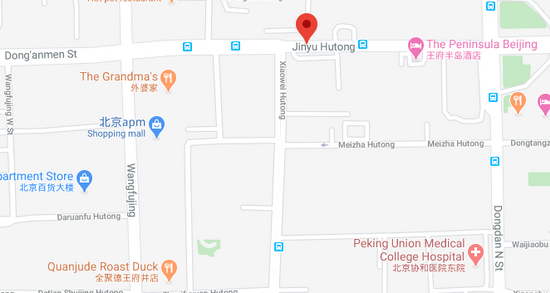
It now actually a commercial street with several luxuary hotels and high-rise buildings. Here you cannot find any flagstone roads nor courtyards.
Address: from Dongdan North Street to Wangfujing Street, Dongcheng District
Attractions nearby : Wangfujing Street and Wangfujing Church (St. Joseph’s Wangfujing Cathedral)
Subway: Line 5 to Dengshikou, Exit C
Xijiaomin Alley ( Xi Jiao Min Xiang) 西交民巷
This 1080-meter long hutong was called Xijiangmi Alley and the north of the alley were several central institutions in Ming Dynasty. The alley was renamed “Xijiaominxiang ( Xijiaomin Alley ) in Qing Dynasty.
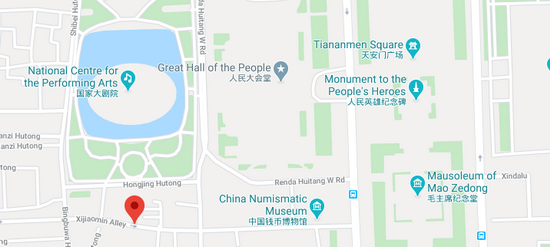
At the end of Qing Dynasty and the beginning of Republic of China, Xijiao Minxiang was also called bank Street.
Today you still can see the old bank buildings – the old site of the Central Bank Peiping Branch, the old site of China Agricultural and Industrial Bank, and the old site of the mainland bank, the old site of Beiyang Commercial Bank (the two were built into the new China Numismatic Museum in 2002 and other cultural relics protection units.
Bada Hutong ( Eight Great Hutongs ) 八大胡同
Bada Hutong refers to a cluster of eight hutongs, more popularly known as “Eight Great Hutongs”. The eight hutongs are Baishun Hutong, Yanzhi Hutong, Hanjiatan (now Hanjia Hutong), Shaanxi Hutong, Shitou Hutong, Wang Guangfu Xijie (now Palm Tree Xijie), Zhu Jia Hutong, Li Shamo Hutong (now Dali Hutong and Xiaoli Hutong).
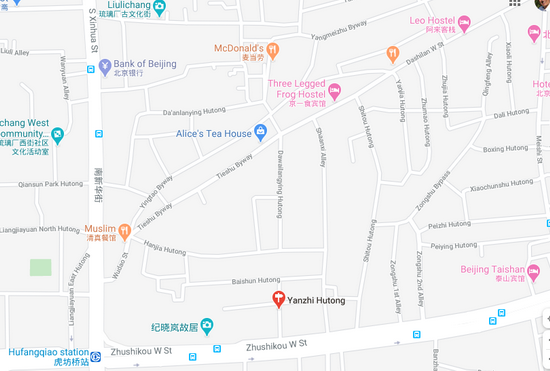
The eight hutongs were rife with brothels before in 1949. So when a man told you he would go to the eight great hutongs, he actually wanted to let you know what he would do instead of going to any of the exact hutongs. In fact, “eight” is an imaginary number here, just to show there are many.
Broadly speaking, the Eight Hutongs refer to a number of hutongs in a large area south of Tieshu Byway, north of Zhushikou West Street, east of South Xinhua Street, and west of Meishi Street.
Tip: Hassle-free Beijing Guided Tours
If you don’t want to go the do-it-yourself route and prefer the hassle-free escorted tours, here are some options for Beijing guided tours:
Car Rental in Beijing
Beijing Day Tour
Beijing Tour Packages
Beijing Winter Tour
Great Wall Tour
Beijing Tours
China City Tours
China Tour
Further Readings
Best Time to Visit Beijing
How to plan a trip to Beijing
Top 10 Attractions in Beijing
How to Visit Forbidden City
How to Visit Temple of Heaven
How to Visit Summer Palace
How to Visit Ming Tombs
How to Visit the Great Wall of China
How to Visit Tiananmen Square
How to Visit Hutongs
How to Visit Olympic Sites
Top 10 Markets in Beijing
Top 10 Shopping Malls in Beijing
Beijing Shopping
Wangfujing Night Snack Street
Qianmen Commercial Street
Beijing Huguosi Street
Any questions, just drop a line.






